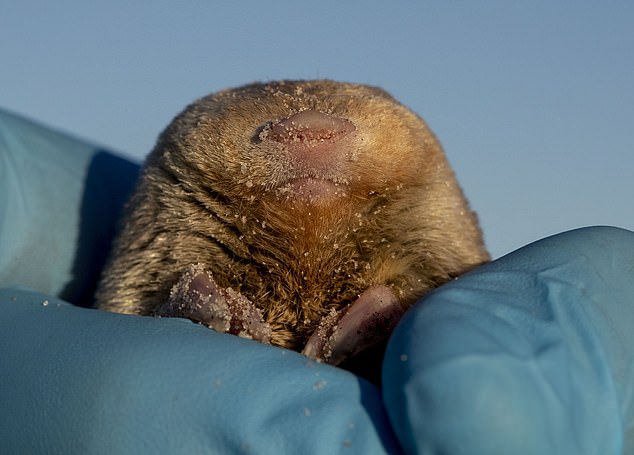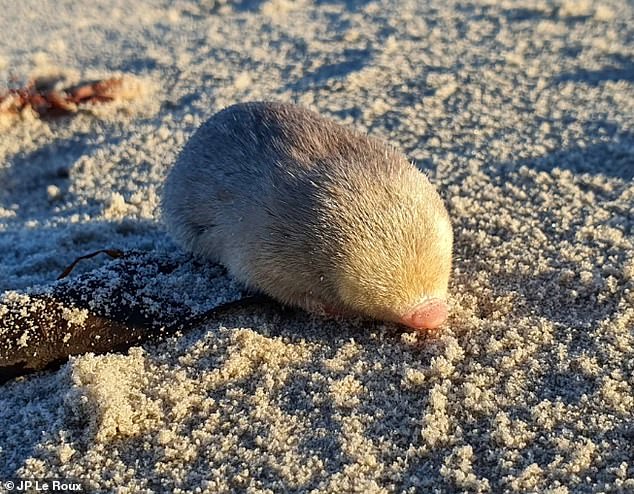Golden mole with ‘super-hearing powers’ thought to be extinct in South Africa is seen for the first time since 1936
A mole with a shiny golden coat, considered extinct in 1936 after all traces of the species disappeared, was discovered on a beach in South Africa.
Known as the de Winton's golden mole, this blind animal with superior hearing abilities was discovered in Port Nolloth on the west coast of South Africa by a team of researchers from the Endangered Wildlife Foundation (EWT) and the University of Pretoria.
These small, hamster-sized mammals spend most of their lives underground and avoid humans, making them easy to miss.
This particular species was threatened by diamond and mineral mining activities in Africa, and when science lost sight of it 86 years ago, researchers assumed it was extinct.
But using DNA taken from the sister golden mole, scientists were able to track him down with the help of a sniffer dog who led them to tunnels hidden on the beach.
A mole with a shiny golden coat, which was considered extinct in 1936 after all traces of the species disappeared, was discovered on a beach in South Africa.
The researchers began their research in 2020, using specimens from De Winton's sister species, the critically endangered Van Zyl's golden mole, to see if the technique was viable.
Golden moles are native to sub-Saharan Africa, and golden moles are only found in the Port Nolloth area.
Following the successful results of the pilot study, in 2021 the team set off for the West Coast in search of the elusive animal.
“We had high hopes, but our hopes were also dashed by a few people,” Samantha Meinhardt, a biologist at Stellenbosch University, told the Associated Press.
“One De Winton expert told us, ‘You won’t find this mole.’ It’s extinct.”
The team and their sniffer dog, a border collie named Jesse, scanned the 985-foot beach, looking for small tunnels dug into the sand.

These small mammals, about the size of a hamster, spend most of their lives underground and avoid humans, making them easy to miss

This particular species was threatened by diamond and mineral mining activities in Africa, and when science lost sight of it 86 years ago, researchers assumed it was extinct.
The dog used the DNA of a sibling mole to sniff out the supposedly extinct animal.
Meinhardt wrote in The Conversation that she and Jessie scoured about a foot of the beach each week until the dog picked up the scent that led to tiny tunnels flowing under the sand.
The team took soil samples to confirm that it was made from de Winton's mole.
The samples included the animal's hair, skin, cells and secretions, which the team extracted and compared with the species' DNA.
However, the DNA was not a match because it did not come from De Winton's mole.
Although the DNA did not match any other known golden mole species, there was not enough evidence to declare de Winton's golden mole rediscovered.

The researchers scanned about one foot of the beach each week until the dog picked up the scent that triggered small tunnels along the sand.
The team then conducted further morphological and genetic analysis on the golden moles found on the beach.
The missing evidence is found in 2022 in Port Knolloth Museum, which has an ancient specimen of de Winton's golden mole in its collection.
A separate team of researchers sequenced many of its genes, allowing EWT to compare the results with soil samples — and it succeeded. It was a match.

There are 21 species of golden moles, most of which live only in South Africa. These tiny creatures have an oily secretion that decorates their fur with an iridescent sheen, giving them the name “golden mole,” allowing them to “swim” across the sand.
Two De Winton golden moles have now been confirmed and photographed in Port Nolloth, while the research team has found signs of other populations in the area since 2021, Meinhardt said.
“It was a very exciting project with many challenges,” said Esther Matthew, chief field officer at the Endangered Wildlife Trust.
“Fortunately, we had a great team full of enthusiasm and innovative ideas, which is exactly what you need when you have to survey up to 18 kilometers (11 miles) of dune habitat in one day.”
There are 21 species of golden moles, most of which live only in South Africa.
These little creatures have an oily secretion that lubricates the fur with an iridescent sheen, giving them the name “golden mole,” allowing them to “swim” through the sand.
De Winton's golden mole was one of the top 25 animals on a list of long-lost species compiled by the non-governmental group Re:wild in 2017.
Eleven more have now been discovered.
Christina Biggs, a lost species specialist at Re:wild, praised the team's tenacity in finding the moles.
“They left no sandhill untouched, and now it is possible to protect the areas where these rare and threatened moles live,” Biggs said.
(tags for translation) Daily Mail
